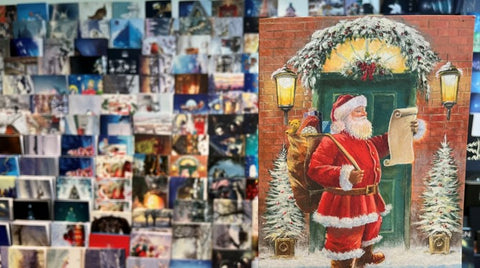Christmas Cards
Christmas cards are a beloved tradition, deeply embedded in the holiday season's tapestry. These small pieces of art and sentiment hold an enduring place in our hearts and homes. While today we exchange Christmas cards to convey our warmest wishes and reconnect with loved ones, their history is rich and their benefits extend beyond mere words. This exploration delves into the origins, evolution, and numerous advantages of sending and receiving Christmas cards.
Part I: A Glimpse into the Origins
1. The Early Roots of Holiday Greetings
The tradition of sending Christmas cards can be traced back to ancient civilizations. In Egypt, papyrus scrolls decorated with images of birds and plants were exchanged as New Year's greetings. Similarly, in China, New Year's messages were sent on paper. The concept of sending greetings during festive seasons is an age-old practice, reflecting a universal human desire to connect with others during special times.
2. Victorian Era: The Birth of the Christmas Card
The modern Christmas card as we know it was born in Victorian England. Sir Henry Cole, a British civil servant, and John Horsley, a London-based artist, are credited with creating the first Christmas card in 1843. The card featured a festive family scene and the words "A Merry Christmas and a Happy New Year to You." These early cards were not just for sending good wishes but were a means to alleviate the burden of writing individual letters during the holiday season.
3. Early Evolution: Artistic and Creative Expression
In the mid-19th century, the production of Christmas cards flourished. Renowned artists like William Egley and Richard Doyle began contributing their art to these cards. The evolution of printing technology also played a crucial role, making it easier and more affordable to produce cards in larger quantities. The designs ranged from religious scenes to depictions of festive gatherings, often reflecting the period's popular art styles.
Part II: Benefits of Christmas Cards
4. A Source of Connection
One of the primary benefits of Christmas cards is their ability to connect people across distances. In today's globalised world, where loved ones may be scattered far and wide, receiving a Christmas card can be a heartwarming reminder of the connections we hold. It fosters a sense of closeness even when miles apart, uniting friends and family during the holiday season.
5. Spreading Joy and Positivity
Christmas cards are miniature bundles of joy and positivity. They carry heartfelt wishes for a wonderful holiday season and a happy New Year, bringing smiles to the faces of recipients. In a world that often feels fast-paced and hectic, these cards serve as a simple yet powerful reminder of the importance of spreading happiness and good cheer.
6. Personalisation and Thoughtfulness
Sending a Christmas card is an act of thoughtfulness. The time taken to select a card, write a personal message, and address it to the recipient is a labor of love. The personalised touch adds value to the card, making it a reflection of the sender's sentiments and affection.
7. Historical Significance
Christmas cards have a historical and cultural significance. They carry traditions and stories of bygone eras. As we exchange these cards, we honor the history and heritage of this practice, linking our present to the customs of the past. This sense of continuity is a special benefit of Christmas cards.
8. Reflection and Gratitude
Writing Christmas cards often involves a moment of reflection. It's a time to think about the past year, express gratitude for the people in your life, and set positive intentions for the year to come. The act of writing a card can be a therapeutic and grounding experience.
9. Supporting Artists and the Greeting Card Industry
The production and exchange of Christmas cards contribute to the livelihoods of artists, graphic designers, printers, and the greeting card industry as a whole. Many artists and designers create beautiful, unique Christmas card designs, and sending these cards helps support their craft and creativity.
10. Environmental Considerations
While it's essential to recognise the benefits of Christmas cards, it's equally important to consider the environmental impact. Traditional paper cards can be resource-intensive, but many individuals and companies are now opting for eco-friendly options, using recycled materials and sustainable printing practices to mitigate their environmental footprint.
Part III: Modern Trends and Digital Cards
11. The Digital Age and E-Cards
In the digital age, we've seen the emergence of electronic Christmas cards or e-cards. These are electronic versions of traditional cards, often sent via email or shared on social media. While they offer convenience and speed, they may lack the tactile and personal nature of physical cards.
12. The Coexistence of Digital and Traditional Cards
The rise of digital alternatives has not replaced traditional Christmas cards but coexists with them. Many people still prefer to send and receive physical cards because they offer a sensory experience that digital cards cannot replicate. The choice between digital and traditional cards often depends on individual preferences.
Part IV: Special Types of Christmas Cards
13. Handmade and DIY Cards
Handmade Christmas cards add a unique, personal touch to the tradition. Crafting your own cards allows for creative expression and can be a meaningful activity for families and individuals. Handmade cards also often become cherished keepsakes.
14. Charity Cards
Many Christmas cards are sold by charities, with proceeds supporting various causes. By sending charity cards, you can contribute to a charitable organisation while sharing holiday greetings. These cards exemplify the spirit of giving during the Christmas season.
15. Photo Cards
Photo cards have become increasingly popular, allowing people to share family portraits, snapshots of memorable moments, and updates on their lives. Photo cards are a way to showcase the beauty and growth of one's family and create a personalised connection with recipients.
Part V: The Future of Christmas Cards
16. Adapting to Changing Times
As society continues to change and adapt to new technologies, the tradition of sending Christmas cards may also evolve. While the fundamental virtues of Christmas cards—connection, joy, and thoughtfulness—remain timeless, the means of exchanging these sentiments may continue to diversify.
17. Sustainability and Environmental Considerations
The future of Christmas cards will likely include an increased focus on sustainability. Many people are becoming more conscious of the environmental impact of paper cards and are exploring eco-friendly alternatives. Companies and individuals are embracing recycled materials and responsible printing methods.
18. Virtual Reality and Augmented Reality Cards
The use of technology may further enrich the Christmas card experience. Virtual reality (VR) and augmented reality (AR) cards could provide immersive, interactive elements, enhancing the way recipients engage with their cards.
Conclusion
The history and benefits of Christmas cards are a testament to the enduring power of tradition, connection, and heartfelt expression. While the ways in which we send and receive Christmas greetings may continue to evolve, the core virtues of these cards remain constant. In a world often marked by haste and digital interactions, Christmas cards offer a moment to slow down, reflect, and spread joy, making them a cherished part of the holiday season that transcends time and technology.


